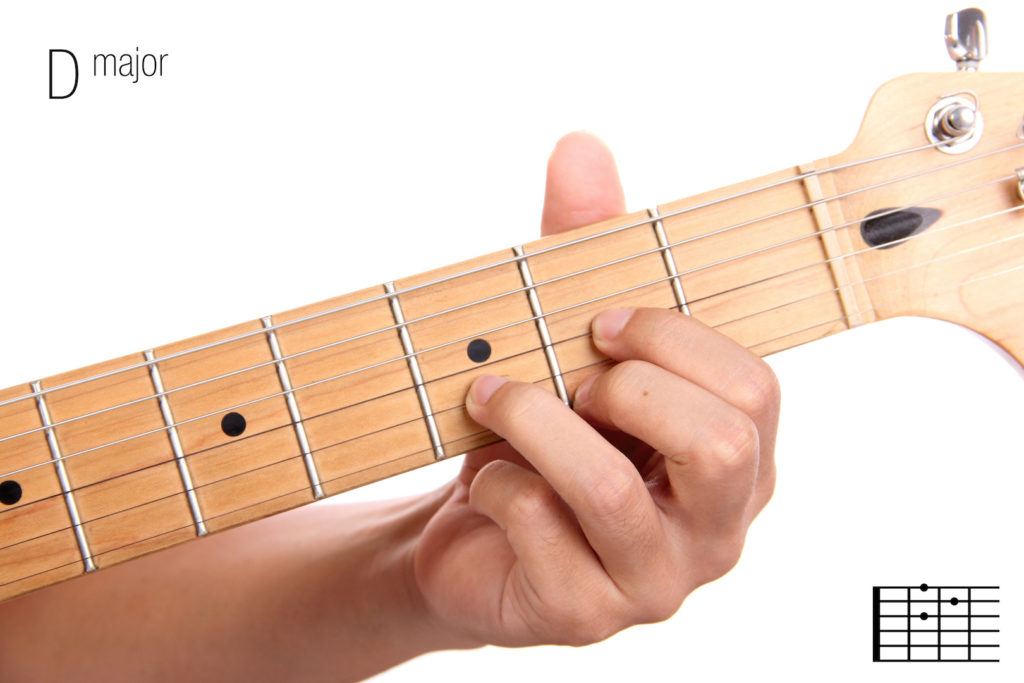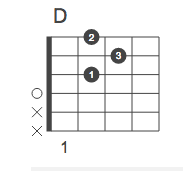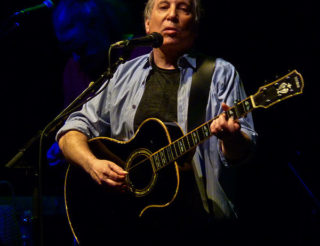D Chord on Guitar (easy): Chord Shapes, Major Scale, Popular Songs in the Key of D
Author: Wanda Waterman

Welcome to the second article in our “Chord of the Week” series. We’ll be sharing a new guitar chord every week, exploring its history, its relevance, how it’s played on the guitar, its major scale, some common chord progressions, and a few popular songs in the key of the chord.
This week we’re bringing you the D Major chord, the root chord of the key of D.
Table of Contents
D Major History Lesson: Little Miss Popularity

It’s the third most popular key used in all songs on Spotify, but we’re willing to bet that if you took out all the doom, the gloom, and the my-baby-done-left-me blues, you’d probably find that most popular songs are played in the key of D.
 In the Baroque period the key of D major was often called “the key of glory,” and it went on to become one of the most popular keys for composers of the classical and romantic periods. Because the violin’s strings are tuned to GDAE (like a backwards bass guitar) they’re naturally sympathetic to the key of D, and thus many great composers, including Beethoven, Mozart, Tchaikovsky, and Stravinsky, wrote violin concertos in this key.
In the Baroque period the key of D major was often called “the key of glory,” and it went on to become one of the most popular keys for composers of the classical and romantic periods. Because the violin’s strings are tuned to GDAE (like a backwards bass guitar) they’re naturally sympathetic to the key of D, and thus many great composers, including Beethoven, Mozart, Tchaikovsky, and Stravinsky, wrote violin concertos in this key.
At the other end of the cultural spectrum, one reason for the popularity of the key of D Major is the fact that historically most tin whistles have been playable only in D, which meant that if you wanted to play your guitar along with the pub’s whistler, you had to play in D.
The D Chord Position on the Guitar: Giving Wings to Your Guitar Strings
Why is it that when you hear a song that’s filled with joy, hope, and glory (like Paul McCartney’s “Maybe I’m Amazed”), or, on the other hand, a song that takes life’s lemons and turns them into lemonade (like Jimmy Cliff’s “I Can See Clearly Now”), you’ll find that the song is written in the key of D? Because that’s precisely the character of this amazing key. D has a magical power to lift you up and set you on a mountaintop.
Plus, on a purely practical level, if you sing along with your guitar and haven’t yet developed a broad vocal range, you’ll probably find the high and low notes in the key of D easy to hit without straining.
How to Play the D Chord Position on Your Guitar
The D Major chord is fairly easy to play on the guitar because the guitar’s strings are EADGBE, thus two of the notes of the D chord, D and A, are already available in the open strings, and so a basic D chord only requires three fingers.
The strings that are held down resonate beautifully with the open strings, creating a bright sound. Some guitarists even use “drop D tuning,” tuning the low E string down to a D to make an especially rich, resonant D chord!
Learning the D Major chord right after learning the C Major chord is a bit of a treat for two reasons,
1) as mentioned already, it has an uplifting sound, and
2) it’s easier to play, not needing quite the same degree of stretch.
!function(e,r,d){var t,c=e.getElementsByTagName(r)[0];e.getElementById(d)||(t=e.createElement(r),t.id=d,t.src=”https://uberchord-backend.firebaseapp.com/uberchord-embed-sdk.js”,c.parentNode.insertBefore(t,c))}(document,”script”,”uberchord-jssdk”);
The best way to play this chord is to use the first three fingers, one holding down each string. As you’ll soon see as you progress with your Uberchord (click for free download) lessons, this position is an ideal “base camp” for your fingers, allowing them to reach out across the fret board to bend strings, create new chords, hammer-on, hammer-off, and easily switch between chords.
This may be one reason why legendary singer-songwriter Gordon Lightfoot ended up just using his capo and playing all of his songs with the basic key of D chord positions!
Theory and Practice: The Pattern of the D Major Scale Explained
If you’ve already learned a little music theory (if you haven’t here’s a great place to start) you’ll know that the sequence of intervals in a major key are:
whole tone, whole tone, half tone, whole tone, whole tone, whole tone, half-tone
In other words, at the third and the seventh places in the scale there’s a half tone, and between all the other notes there are whole tones.
This means that the scale of the key of D is made up of the notes D, E F#, G, A, B, and C#.
Here is the D scale, with D at its root and another D, an octave higher, at its summit. On the guitar this D can be played on the fourth string, open. The higher D can be played on the second string, third fret.
The D Major chord, which forms the root of this scale, is made up of the notes D, F#, and A— the first, third, and fifth notes of the key of D. On the guitar, using the basic D chord position, these notes arrive in this order: A, D, A, D, and F#. (The low E string, the first, is not played, but if you want to tune this string down a whole tone, you can play this string, too, for a fuller-sounding chord.)
If all this is sounding a little heavy right now, don’t worry— the Uberchord blog has a great series of music theory articles to guide you through the dark forest and into the bright plain of musical understanding. Knowing the theory behind the practice will help you to be a better musician and give you the peace of mind that comes with knowing exactly what you’re doing and how it all fits together. Learning music theory on the side is a great complement to using the free Uberchord app!
Common Chord Progressions in the Key of D
If you were to use every chord in the key of D Major, these would be the chords you would use. You aren’t strictly limited to using chords in the same key, but it helps to know them. So here they are:
D, E minor, F# minor, G, A7, B minor, and C# diminished.
Why are the second, third and the sixth chords minor? Because in the major scale the chords at the second, third, and sixth positions of the key are minor. That’s just how it is.
Why is the C# a diminished chord? Same reason.
Why is the A an A7? Because it sits in the fifth position of the key of D, which gives it the honour of being the chord that announces that a musical phrase is about to end. (Play some of the chord progressions below and you’ll see what we mean.) Adding the seventh note of the key of A (G) to the A chord makes the A sound a little more top heavy, making it seem as if it’s about to fall over onto the root chord (D) that comes next, or, in cases where no chord comes next, giving the musical phrase an unfinished, “leaving them hanging” kind of sound.
If you want to go more deeply into chord progressions and what they mean, check out this article series on chord progressions. For now we’ll just touch on the basics. After your Uberchord (click for free download) lessons you can take a little time to experiment with the following progressions to get a feel for how the chords create a sense of beginning, development, and ending, depending on their context.
!function(e,r,d){var t,c=e.getElementsByTagName(r)[0];e.getElementById(d)||(t=e.createElement(r),t.id=d,t.src=”https://uberchord-backend.firebaseapp.com/uberchord-embed-sdk.js”,c.parentNode.insertBefore(t,c))}(document,”script”,”uberchord-jssdk”);
“Here Comes the Sun” by George Harrison
Obviously you can’t just start playing all the chords in the key of D and expect it to sound like music. The following are a few common chord progressions in this key. Most of the songs you hear in D are made up of combinations of these and other chord progressions. As you play them and get used to their sound, you’ll hopefully realise that you’ve heard them before in many different incarnations.
- D — G — A7 — D (Most basic)
- D – A7 – B minor – G
- D – B minor – G – A7
- D – A7 – B minor – F# minor – G – D – G – A7
- D – D – D – D – G – G – D – D – A7 – A7 – D – D (Blues)
- E minor – G – A7
- D – G – A7– G
- A7 – G – D
- B minor – G – D – A7
- B minor – A7 – B minor – A7
Vitamin D — the Sunshine Vitamin: Just A Few Great Songs in the Key of D
As we already mentioned in the last article the the C chord, the more you play, the more you’ll notice that each key has its own peculiar emotional character.
Because the key of D is so sunny and hopeful it can handle optimistic anthems like Joe Cocker’s “Love Lift Us Up Where We Belong.”
It can be exuberantly catchy, like “Wake me up” by Avicii.
It can be a rock rouser like Pink Floyd’s “Comfortably Numb”
It can be bittersweet and bluesy like B.B.King’s “Thrill Is Gone”
It can be an iconic and perennially soothing anthem piece, like The Eagle’s “Hotel California”
Hopefully you’ll soon see the D chord as the kind of friend you never want to part with— there with a smile through both the smooth sailing and the bumpy roads.
We hope you learned a lot about this great chord and have some inspiration to go play it! Some other articles on our site can help you learn more ways to practice and use it like our article on the born to be wild chords or the one that’ll help you learn how to get good at guitar chords. We also have lots of theory articles to help give new insights into the guitar like this one covering how many half steps is a tritone.
References:
Characteristics of Musical Keys
A History of Key Characteristics in the Eighteenth and Early Nineteenth Centuries, by Rita Steblin
The 10 Most Used Chord Progressions in Pop and Rock and Roll









No comments yet - be the first.